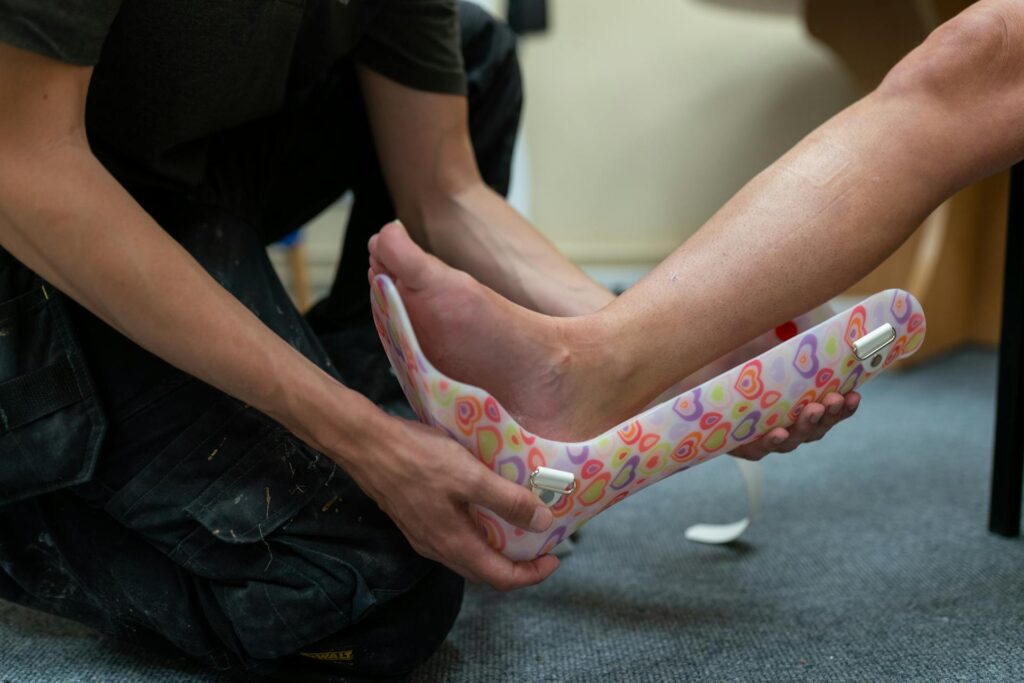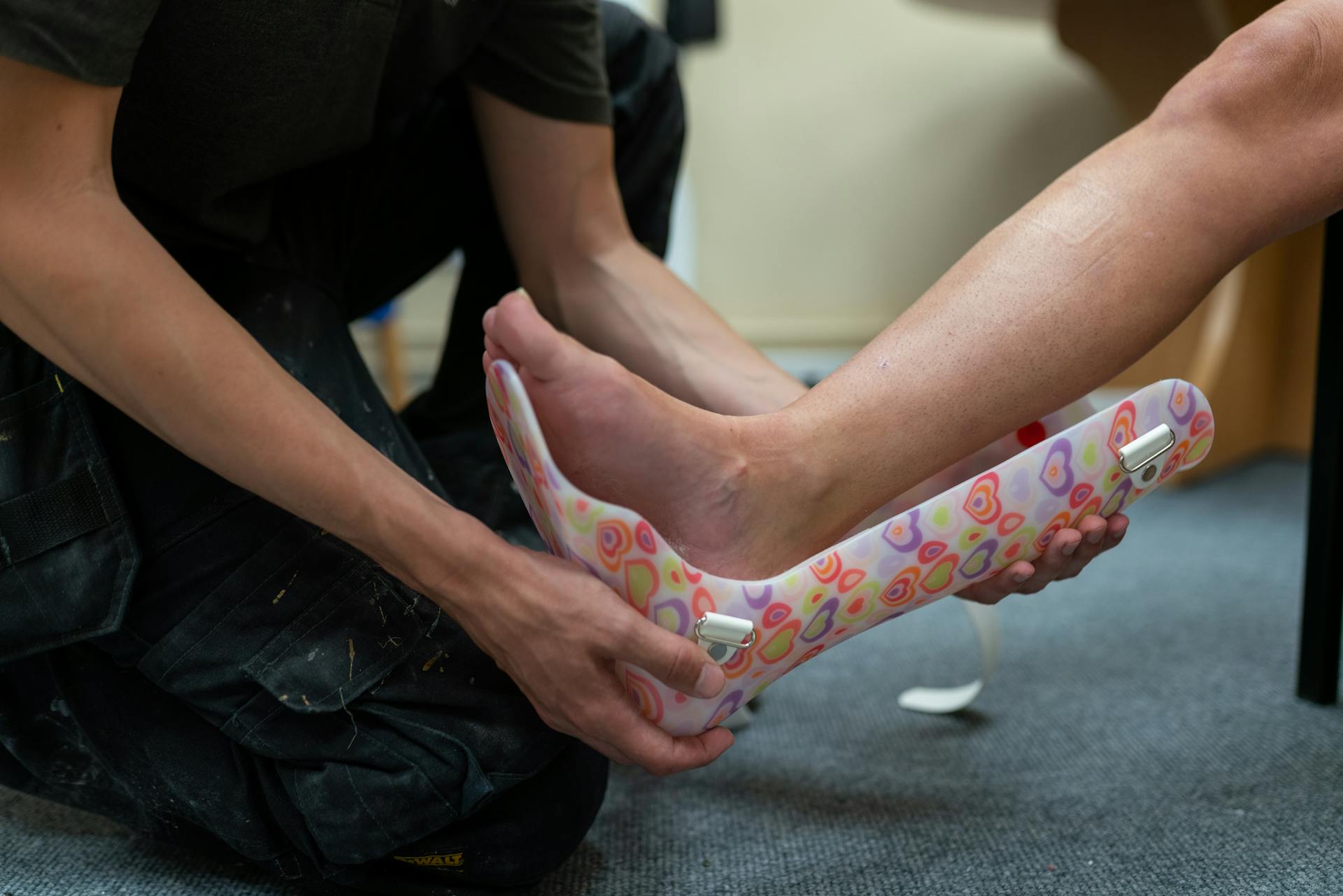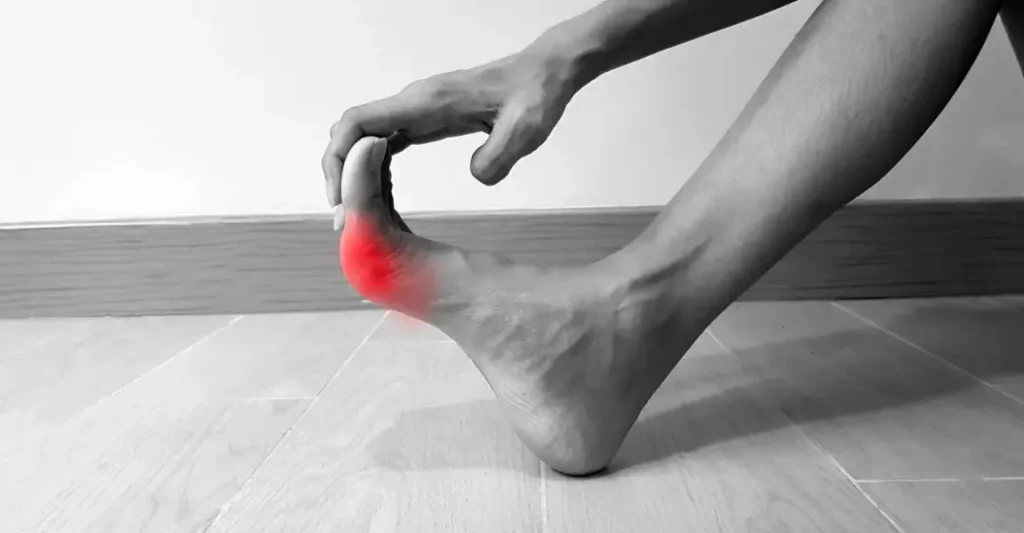The human foot, as a conglomeration of bones, tendons, nerves, and other things, has its own unique structure and function. Any problem in these components can cause pain and discomfort in the foot. Among these discomforts are two common conditions that are notorious for their similar symptoms but differ greatly in treatment, thus requiring that an accurate diagnosis be given.
Therefore, healthcare workers must possess a comprehensive knowledge of the distinguishing features of each disease to ensure correct diagnosis and targeted interventions. The inability to distinguish fat pad atrophy vs plantar fasciitis and heel fat pad syndrome vs plantar fasciitis or a wrong diagnosis could result in ineffective treatment and a prolonged period of miserable patient suffering.
According to statistics, plantar fasciitis is the most commonly diagnosed heel condition follow by heel pad syndrome. However, these two heel conditions are often mistaken for one another, making it difficult to pinpoint the actual source of heel pain.

What is the difference between Heel Fat Pad Syndrome and Plantar Fasciitis?
The major difference between heel fat pad syndrome and plantar fasciitis is that the pain from the latter occurs in the center part of the heel, while the former takes place in the edge of the heel, closer to instep, towards the toes. Another area of difference between the two is that pain from plantar fasciitis is usually triggered when the patient stands up after a prolonged period of rest. For instance, in plantar fasciitis, there is pain with the first step of the day. This pain eases within ten minutes but returns towards the end of the day. It is also present after periods of rest and then standing (post static dyskinesia). On the other hand, fat pad atrophy heel pain typically starts ten to fifteen minutes after walking and persists. It gets worse the longer you place pressure on the heel.
Addressing Specific Symptoms For Effective Treatment
It is important to pinpoint the cause of heel pains for precise disease treatment. Plantar fasciitis, for instance, can often respond well to stretching exercises; on the other hand, heel pain associated with fat pad atrophy does not respond to stretching treatments. Heel fat pad atrophy or trauma is an entirely different matter and may require cushioning inserts or fat pad restoration into the atrophied heel fat pad where it cushions the foot.
A person may suffer from foot pain, difficulty walking, and impeded ability to make a living or do sports. People who suffer from these long-term disorders are facing more severe problems that affect their quality of life and their overall health. We have treated patients from around the world and have helped them walk because of atrophy of the fat pad. If we take advantage of treatments and intervene promptly when foot symptoms are present, our quality of life will improve substantially, and we will return to normal functions faster. We are one of the few places that offer fat pad rejuvenation techniques to help restore the cushioning in your feet. Plus we completed the first approved FDA study on the benefits of using a dermal filler to help off load painful pressure points.
Understanding Plantar Fasciitis
What is Plantar Fasciitis?
The plantar fascia is made up of thick connective tissue made of collagen that bind the heel to the front part of the foot. The inflammation of these tissues is called plantar fasciitis. The plantar fascia supports the arch of the foot and helps absorb the impact of walking and other physical activities on the foot. Pain from plantar fasciitis occurs on the bottom of the foot, in the area between the heel and arch.
What Causes Plantar Fasciitis?
The foot condition known as plantar fasciitis results from a variety of factors:
Overuse or repetitive strain: Prolonged standing, walking, and running activities that involve the plantar fascia are placed under excessive strain, and this physically damages those structures. It also results in inflammation.
Mechanical abnormalities of the foot: Foot types such as a high arch foot (pes cavus foot) and , flat feet (pes planus) , lead toabnormal foot mechanics. These can alter weight distribution and the amount of pressure on the plantar fascia, increasing your injury risk.
Ill-fitting footwear: When wearable shoes lack adequate support or cushioning, they can further stress your plantar fascia and put people at higher risk for plantar fasciitis.
Obesity or excess weight: Increases the weight carried by both feet to a certain degree.
Age and activity level: Plantar fasciitis is generally more common among middle-aged people who do work that entails standing on their feet for prolonged periods of time, such as nurses and others who engage in activities that leave them vulnerable to repetitive strain on the feet.
Plantar Fasciitis Symptoms and Diagnostic Methods
The classic symptom of plantar fasciitis is heel pain, usually felt on the inside or bottom part of the heel. Pain is often most severe in the morning when one takes the first steps after getting out of bed or after sitting for a long time. It is followed by activity or exercise but eventually returns after standing or walking for a long time.
Other common symptoms include:
- Pain that gets worse with activity and better during rest periods
- Sharp or stabbing discomfort may occur along the underside of the foot, but not always in that spot, particularly if you are moving about.
- Stiffness accompanied by limited motion in the foot and ankle area
- Tenderness and swelling around or at fingers down from the heel area.
A diagnosis is made after all forms of plantar fasciitis have been ruled out. The diagnosis may include taking a detailed medical history and examining the person’s feet. X-rays or an ultrasound may be done to ensure that other factors do not cause heel pain and to evaluate the extent of its damage. Always ensure entrapment neuropathies are not present at the same time, which would include symptoms of burning or numbness.
Plantar Fasciitis Treatment
Treatment of plantar fasciitis is aimed at the relief of pain, inhibition of inflammation, easing fatigue, and treatment of the damaged tissues. Usually, injuries are handled conservatively, to begin with:
- Rest as much as possible
- Ice to reduce inflammation
- Stretching exercises (you want to feel the stretch in the calf)
- Orthotics/other auxiliary devices to provide better arch support or padding
- RICE therapy can also be used: Rest, Ice, Compression, Elevation
- Wearing laced sneakers and not walking barefoot as well as home recovery sandals.
- Protein Rich Plasma and Amnion Injections are both regenerative therapies that aim to heal the collagen tissue.
- Radial wave or shock wave therapy to promote healing.
- Laser Therapy helps reduce inflammation and increase oxygenation and blood to the area for healing.
If conservative therapies fail, more aggressive measures, such as corticosteroid injections, may be tried. In the most severe, refractory cases of plantar fasciitis, when modern techniques have failed to provide relief, surgery is a last resort. Most cases even severe or recalcitrant plantar fasciitis can be treated
Understanding Heel Fat Pad Syndrome
What is heel fat pad syndrome?
Heel fat pad syndrome, or fat pad atrophy, is characterized by degenerated or injured heel fat pads. Cushioning and the density and quality of the heel fat pad decreases With the lack of cushioning and shock absorption, patients are in pain as they are essentially walking directly on their bone.
What causes heel fat pad syndrome?
Several factors may contribute to the development of this condition, including:
Aging: The natural aging process can lead to progressive degeneration and thinning of the heel’s fat pad, reducing its capacity to absorb shocks.
Heavy weight-bearing activities over time: Activities that require long periods of standing or walking on hard surfaces may quicken the wear and tear of the fat pad, leading to atrophy and loss of resiliency.
Trauma or injury: Direct trauma to the heel, such as that caused by running or jumping, as well as a violent blunt force type of impact, result in inflamed and painful heel fat pads.
Biomechanical factors: Abnormal foot mechanics, including excessive pronation or supination, will change the weight distribution and pressure on fat pads under the heel, predisposing them to injury and degeneration.
Cortisone injections: Patients that have repeated cortisone injections for plantar fasciitis are at risk, because cortisone can help with the inflammation of the fascia, but causes atrophy of the fat pad with time. This is called cortisone induced lipoatrophy.
Autoimmune Conditions: Many people who suffer from autoimmune disorders have weakening of the heels supportive structures and the density of the fat pad is lost.
Heel Fat Pad Syndrome Symptoms and Differential Diagnosis From Plantar Fasciitis
Symptoms and diagnosis can differentiate heel fat pad syndrome vs. plantar fasciitis. Moreover, heel fat pad syndrome typically manifests as a local pain and tenderness beneath the heel, often described by patients as a deep ache instead of the sharp, stabbing pain associated with plantar fasciitis.
Heel fat pad syndrome also differs from plantar fasciitis because it often leaves patients wincing for a few steps and in considerable pain after pauses in walking, and pain may persist with no apparent cause and then disappear once weight-bearing activity is finished.
Other characteristics that can help distinguish these two conditions from each other include:
Area and nature of pain: Heel pad syndrome normally produces pain directly under the heel, while plantar fasciitis usually causes pain along the bottom of the foot from the heel to the arch.
Characteristics of pain: Heel pad syndrome may manifest as a vague, deep ache. Plantar fasciitis often gives the appearance of sharp, stabbing pain, especially when first getting up in the morning and under compressive loads.
Reaction towards treatment: Heel fat pad syndrome may respond better to interventions that support and cushion the heel where it is impacted. Plantar fasciitis may require treatment measures that target the plantar fascia itself.
Heel Fat Pad Syndrome Treatment
Like plantar fasciitis, the heel fat pad syndrome treatments include:
- Fat Pad Restoration
- Shoe modification / Shoe Inserts
- Wearing heel cups and orthotics
Techniques of Examination and Guidelines for Diagnosis
Diagnosis of heel pad syndrome is based mainly on clinical assessment, which includes taking a detailed history and conducting a physical examination. Examination of the heel area may reveal tenderness and soft tissue swelling consistent with inflammation or atrophy in the fat pad. X-rays and ultrasound imaging studies can measure the integrity and thickness of the heel fat pad to rule out other possible causes, such as stress fractures and plantar fasciitis.
For the correct diagnosis and effective treatment of this foot complaint, a detailed clinical examination, history, and imaging are essential.
Conclusion
One must note the importance of distinguishing between heel fat pad syndrome vs plantar fasciitis to reach an accurate diagnosis and find an effective treatment. Plantar fasciitis refers to an inflammation of the plantar fascia that results in sharp, stabbing pain running from under one’s foot up into the foot; with heel pad syndrome, there is degeneration or injury to the fatty tissue on one’s heel. This causes a deep and dull ache distinctly below the heel itself.
By aiming to develop shared treatment strategies based on medical knowledge about people’s options for these diseases, patients and practitioners may develop individual care plans that will not only relieve symptoms or lessen the chances of foot problems but also address the pathogenesis of these diseases along with mood points. Furthermore, conservative therapies such as rest, stretching exercises, and orthotic devices often prove effective in managing symptoms and improving foot function.
Moreover, preventive measures–such as wearing supportive shoes, maintaining a healthy weight and stretching one’s muscles regularly–can avert the onset of heel pain and enhance overall foot health. Encouraging patient education and educating the patients and knowledge about the latest developments in foot care are indispensable parts of proper disease management.
By creating partnerships between patients and providers of care and emphasizing the need for practical maintenance of foot health, we can contribute toward reducing the burden of heel pain. We can improve the quality of life for hundreds of thousands affected by plantar fasciitis and heel fat pad syndrome worldwide today.
Plantar Fasciitis and Heel Fat Pad Syndrome FAQs
What is plantar fasciitis?
The plantar fascia is made up of thick connective tissues that bind the heel to the front part of the foot. The inflammation of these tissues is called plantar fasciitis.
What factors contribute to plantar fasciitis?
While plantar fasciitis can occur in some patients without apparent cause, factors such as age, gender, foot mechanics, occupation, obesity, high heel, and worn-out shoes can increase the risk of plantar fasciitis.
What are the symptoms of plantar fasciitis?
Symptoms of plantar fasciitis could be: pain occurs in the bottom of the foot closer to the heel, pain often worsens after taking a first step in the morning, pain can be triggered by a prolonged period of standing, activities such as climbing, jogging, and running can be challenging due to heel stiffness.
What is the difference between heel fat pad syndrome and plantar fasciitis?
The major difference between heel fat pad syndrome and plantar fasciitis is that the pain from the latter occurs in the center part of the heel, while the former takes place in the edge of the heel, closer to instep, towards the toes. Another area of difference between the two is that pain from plantar fasciitis is usually triggered when the sufferer stands up after a prolonged period of rest.
What are the treatments for heel fat pad syndrome?
The heel pad syndrome treatments include fat pad restoration, shoe modification, shoe inserts, wearing heel cups and orthotics
Visit Foot, Ankle & Leg Vein Center
If you are sufferring from Plantar Fasciitis or Heel Fat Pad Syndrome, it’s essential that you get a doctor’s opinion.
The Foot, Ankle & Leg Vein Center is your local podiatrist in Boca Raton, and Boynton Beach, FL. We diagnose and treat all kinds of foot, ankle, and leg vein pain, including numbness in toes and feet.
Dr. Jason Gold, DPM, and Dr. Jodi Schoenhaus, DPM, are specialists in treating foot, ankle, and leg vein-related conditions. Both doctors also have extensive experience in sports medicine. Contact us today to get the best treatment for your symptoms and conditions.
References
Jodi Schoenhaus, DPM, and Jason Gold, DPM. Keys To Detecting And Treating Entrapment Neuropathies July 2009. Surgical Pearls from Podiatry Today.
Allam AE, Chang KV. Plantar Heel Pain. 2024 Jan 4. In: StatPearls [Internet]. Treasure Island (FL): StatPearls Publishing; 2024 Jan–. PMID: 29763043.
Buchanan BK, Sina RE, Kushner D. Plantar Fasciitis. [Updated 2024 Jan 7]. In: StatPearls [Internet]. Treasure Island (FL): StatPearls Publishing; 2024 Jan-. Available from: https://www.ncbi.nlm.nih.gov/books/NBK431073/
Chang AH, Rasmussen SZ, Jensen AE, Sørensen T, Rathleff MS. What do we actually know about a common cause of plantar heel pain? A scoping review of heel fat pad syndrome. J Foot Ankle Res. 2022 Aug 16;15(1):60. doi: 10.1186/s13047-022-00568-x. PMID: 35974398; PMCID: PMC9380282.
Kim YH, Chai JW, Kim DH, Kim HJ, Seo J. A problem-based approach in musculoskeletal ultrasonography: heel pain in adults. Ultrasonography. 2022 Jan;41(1):34-52. doi: 10.14366/usg.21069. Epub 2021 Jun 29. PMID: 34674456; PMCID: PMC8696136.




